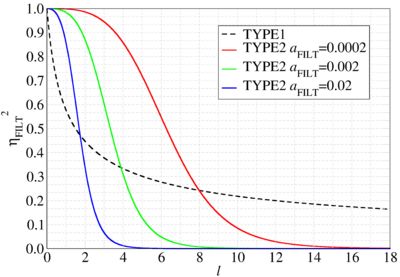ML IAFILT2: Difference between revisions
m (Reverted edits by Miranda.henrique (talk) to last revision by Karsai) Tag: Rollback |
No edit summary |
||
| Line 10: | Line 10: | ||
Following cases are possible for the angular filtering function <math>\eta</math> (see also [[On-the-fly machine learning force field generation using Bayesian linear regression#Basis set expansion|here]]): | Following cases are possible for the angular filtering function <math>\eta</math> (see also [[On-the-fly machine learning force field generation using Bayesian linear regression#Basis set expansion|here]]): | ||
*{{TAG|ML_IAFILT2}}=1: The angular filtering function is described as <math>\eta_{l}=\frac{1}{(2l+1)^{1/4}}</math>. | *{{TAG|ML_IAFILT2}}=1: The angular filtering function is described as <math>\eta_{l}=\frac{1}{(2l+1)^{1/4}}</math>. | ||
*{{TAG|ML_IAFILT2}}=2: The angular filtering function{{cite|boyd:book:2000}} is described as <math>\eta_{l,a_{\mathrm{FILT}}}=\frac{1}{1+a_{\mathrm{FILT}} [l (l+1)]^{2}} </math>. Using this function the parameter <math>a_{\mathrm{FILT}}</math> has to | *{{TAG|ML_IAFILT2}}=2: The angular filtering function{{cite|boyd:book:2000}} is described as <math>\eta_{l,a_{\mathrm{FILT}}}=\frac{1}{1+a_{\mathrm{FILT}} [l (l+1)]^{2}} </math>. Using this function the parameter <math>a_{\mathrm{FILT}}</math> has to be defined too. It is set in the {{TAG|INCAR}} file by setting {{TAG|ML_AFILT2}}. This option is the default. | ||
In the case of the angular descriptor two radial basis functions are multiplied | In the case of the angular descriptor two radial basis functions are multiplied by each other (see [[On-the-fly machine learning force field generation using Bayesian linear regression#Basis set expansion|here]]). Both basis functions use the same filtering function and hence the filtering is done by the square of the filtering function. This is plotted in Fig. 1 for the two different functions used for {{TAG|ML_IAFILT2}}=1 and 2 (labeled as TYPE1 and TYPE2, respectively). In the case of {{TAG|ML_IAFILT2}}=2 it can be seen that for the filtering parameter {{TAG|ML_AFILT2}}=0.02 and <math>l</math>=5 the function has only a contribution of 0.15. Using this filtering parameter the maximum cut-off for the angular quantum number can be reduced to {{TAG|ML_LMAX2}}=4. | ||
Revision as of 14:57, 28 July 2022
ML_IAFILT2 = [integer]
Default: ML_IAFILT2 = 2
Description: This tag specifies the type of angular filtering used in the machine learning force field method.

This tag is only used if ML_LAFILT2=.TRUE. is set.
Following cases are possible for the angular filtering function (see also here):
- ML_IAFILT2=1: The angular filtering function is described as .
- ML_IAFILT2=2: The angular filtering function[1] is described as . Using this function the parameter has to be defined too. It is set in the INCAR file by setting ML_AFILT2. This option is the default.
In the case of the angular descriptor two radial basis functions are multiplied by each other (see here). Both basis functions use the same filtering function and hence the filtering is done by the square of the filtering function. This is plotted in Fig. 1 for the two different functions used for ML_IAFILT2=1 and 2 (labeled as TYPE1 and TYPE2, respectively). In the case of ML_IAFILT2=2 it can be seen that for the filtering parameter ML_AFILT2=0.02 and =5 the function has only a contribution of 0.15. Using this filtering parameter the maximum cut-off for the angular quantum number can be reduced to ML_LMAX2=4.
References
Related tags and articles
ML_LMLFF, ML_LAFILT2, ML_AFILT2



![\eta _{{l,a_{{{\mathrm {FILT}}}}}}={\frac {1}{1+a_{{{\mathrm {FILT}}}}[l(l+1)]^{{2}}}}](https://wikimedia.org/api/rest_v1/media/math/render/svg/c667f6e9ea6c819e649a9f54c0732ee2835a3295)

